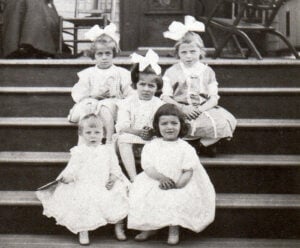 Photograph of children from the author’s family tree. From top left: Amy Hart, Vivian Hart, Harriet Hart (center), Florence Hart, Mary-Elizabeth Hart. C. 1909, Westwood, New Jersey.
Photograph of children from the author’s family tree. From top left: Amy Hart, Vivian Hart, Harriet Hart (center), Florence Hart, Mary-Elizabeth Hart. C. 1909, Westwood, New Jersey.
On November 2, 2022, my husband and I welcomed our first child: a son, named Jack William for his great-grandfathers. Several weeks after Jack’s birth, I requested a copy of his birth certificate from the town offices, an errand which immediately reminded me of submitting vital records requests for genealogical research. Obtaining my son’s birth record was far simpler—I only had to wait a few minutes—and I left the town offices that same day with the record in hand. I looked down at the certificate, with all the fields neatly filled out, and realized genealogical researchers are perhaps the only people who wouldn’t take this record for granted.
Vital records are often the first and best places to check when seeking information about our ancestors. But what is a researcher to do when a vital record simply doesn’t exist, or provides minimal information? In a previous blog post, I discussed the usefulness of family Bibles as vital records substitutes. There are numerous other record types that link parents and their children, with baptismal records and wills being the next best options. Other records that can identify the names of an ancestor’s children include the following types:
Deeds
Not surprisingly, many historical land transactions occurred between parties who were related to each other. This is most evident when grantor and grantee share a last name, though it is common to find documentation of in-laws, cousins, and more distant kin exchanging land as well. Some deeds explicitly refer to the relationship between the grantor and grantee, usually in the case of a father conveying land to a son or daughter. Look for land transactions occurring within a few years of an ancestor’s death, in which heirs of the decedent sell off their interests in the estate. Sometimes out-of-state or otherwise incapacitated heirs will grant power of attorney to a third party, who will conduct the land sale on their behalf.
Historical land deeds for most U.S. states are available on Family Search at the county level. The states of Connecticut, Vermont, and Rhode Island organize their deeds at the town level.
Chancery Records
Black’s Law Directory defines chancery cases as those in which “justice is administered according to fairness as contrasted with the strictly formulated rules of common law.” Unlike civil cases, chancery suits are decided by a judge, not a jury, and include debt, divorce, and estate disputes. Fortunately for genealogists, the complex nature of administering justice based on moral principles generates an extensive volume of paperwork. Documents in a chancery court file may include affidavits from relatives, friends, and neighbors of the plaintiff and/or defendant, correspondence, or copies of wills and plats.
One notable collection of chancery court records is called Virginia Memory: Chancery Records Index, accessible through the Library of Virginia. You can search the collection by surname, and narrow your results by county or year range.
Obituaries
An obvious—though sometimes overlooked—step in identifying an ancestor’s children is to search for a death notice, estate notice, or obituary. While the earliest mortuary notices usually do not give much information aside from the subject’s death date and age, late nineteenth- and twentieth-century notices are more likely to acknowledge the decedent’s heirs. Major repositories to check include Newspaper Archive, Genealogy Bank, Chronicling America (Library of Congress), and Newspapers.com (Ancestry). Some historical newspaper subscription sites, like Genealogy Bank, even allow the researcher to narrow search results to articles tagged as obituaries. If a search of online newspaper databases fails to produce results, check the websites for county and local libraries in the vicinity of your ancestor’s residence. Through library websites, you will sometimes be able to access locale-specific newspaper databases for free. If online databases are not available, you can contact reference staff to inquire about historical newspaper coverage on microfilm.
Cemetery Records
Find A Grave is an excellent resource for locating ancestral graves, but it is important to remember not all memorials listed represent an actual grave. Be wary of memorials that lack tombstone photographs, and use the “Request photo” button to be paired with a local volunteer who can scout the area for your ancestor’s plot. Once the family plot is located, there is a good chance you will find parents buried with at least some of their children; this is especially true in the event of a young child’s death. Also check city and state archives for collections of local cemetery records, which typically consist of documents like burial permits, interment orders, deeds, and lot sales: all documents which may infer, if not outright state, relationships between the person authorizing or paying for the interment and the deceased.
Locating the children of our ancestors who lived before the implementation of modern vital registration systems can seem a daunting task—but that’s what makes the discovery of a revealing land record, court document, newspaper article, or cemetery record even more gratifying!
Share this:

About Jennifer Shakshober
Jen Shakshober earned a dual BA in English and Economics from Westfield State University, an MFA in Creative Nonfiction from Bennington College, and a certificate in Genealogical Research from Boston University. She is currently pursuing an MLIS in Archives Management from Simmons University. Her past research has involved nineteenth and twentieth-century Vermont records from local and state-level repositories. Most recently she wrote two articles about the murder of labor organizer Joseph Shoemaker for The Walloomsack Review, a biannual publication of the Bennington (Vt.) Museum, and she is always interested in crafting narrative genealogical reports.View all posts by Jennifer Shakshober →